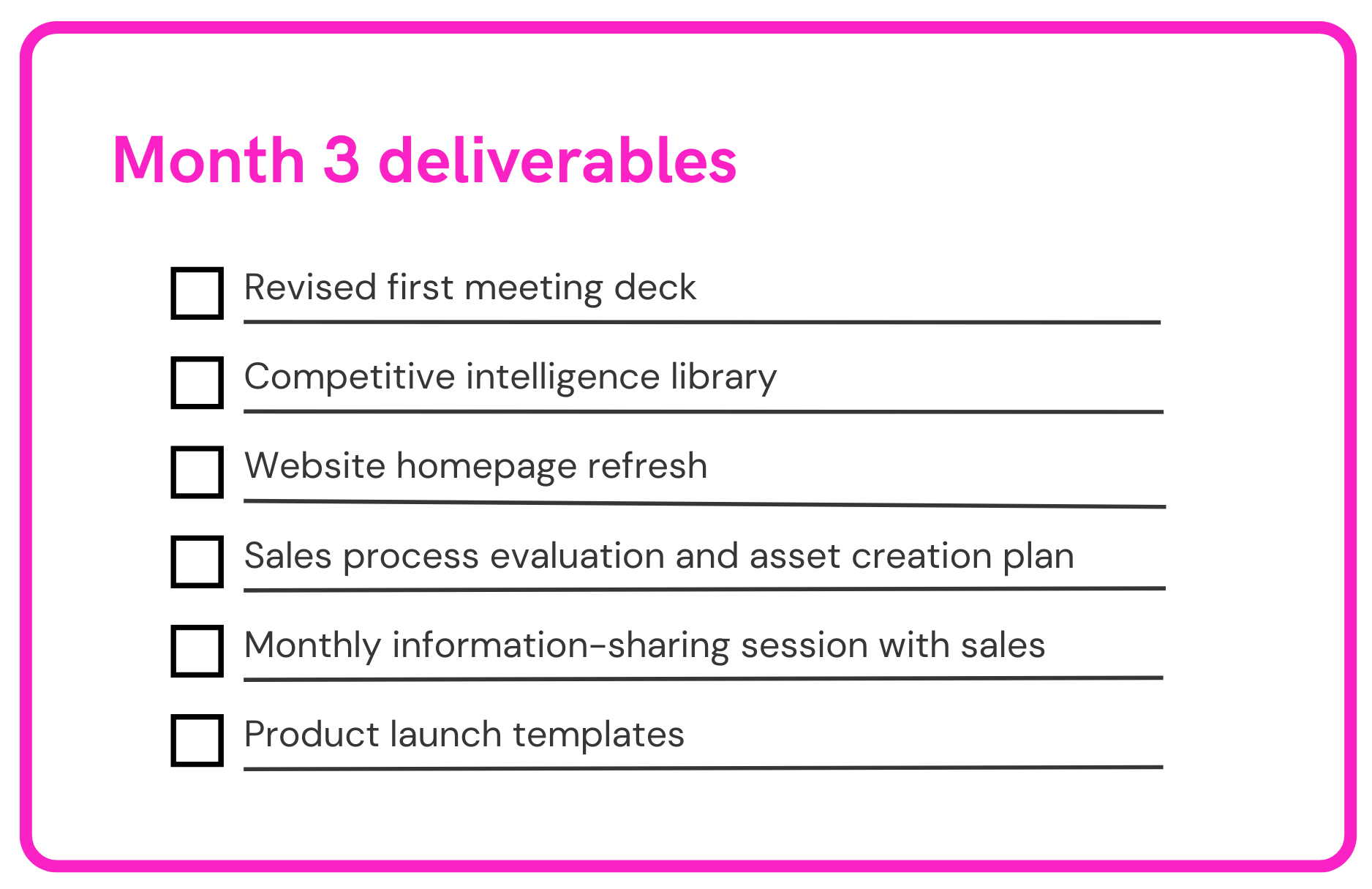On this page
Joining a new company as the first-ever product marketer is both exciting and daunting. As a founding product marketer, you have the opportunity to shape the company’s go-to-market strategy and position yourself as a strategic asset to the business. But whether you’re part of a small marketing team or have been brought on as the first marketing hire, you’ll undoubtedly wear multiple hats and have a task list longer than this blog.
So how do you know where to start? To ensure you impress your new team and make a meaningful impact, here's a roadmap with suggestions for what to deliver during your first 90 days.
The role of a founding product marketer
First off, let’s define the role of a founding product marketer. As marketing functions mature, team members typically get more specialized. Early on, you'll have broad responsibilities, including sales enablement, product launches, web copy, messaging and positioning, competitive intelligence, and anything else thrown your way!
If you're hired as the first marketer on the team, you may also be expected to contribute to lead generation, events, partner marketing, advertising or content. It's an excellent opportunity to learn.
In my opinion the most important aspects of the function are:
Research: You’ll need a thorough understanding of the customers and how the product solves their pain points.
Positioning and messaging: Messaging will change, but having a jumping-off point will set the tone for any other assets you create.
GTM strategy: For a complex sales cycle, you'll partner with sales to understand the process and deliver content that will be helpful in converting any leads.
Product launches: You’ll be in charge or developing assets and promoting any new products or features.

Don’t do anything before you align on goals
Before you do anything, work with leadership to understand their expectations for your role. Learn how you’ll be measured. If you're the only marketer, you could be assessed on lead generation or inbound demo requests. In contrast, a role focused on improving sales collateral could be measured on win rates or sales cycle length.
Based on your goals, create a plan for the next few weeks and check in regularly to ensure you're on track. Review priorities when a new project arises to see if it is worth deviating from the plan. One thing I've learned is that in a fast-moving startup, short-term plans work best as, most likely, things will change.
Your three-month product marketing roadmap
Here’s your cheat sheet for things to focus on in the first three months of the job. There will undoubtedly be projects you’re asked to help with that aren’t on this list, but this should give you a place to start.
Month 1: Listening and learning
The best product marketers take the time to understand the market, the competitors and what makes the company unique. Hopefully, you got a good gauge of these things during the interview process. You’ll have an advantage if you’ve already worked in the industry. Regardless, you should absorb as much knowledge as possible in the first month. Learn about:
- Customers
- The company itself
- The product
- The industry and competitors
Understand the Ideal Customer Profile
Customer research is one of the most important aspects of a product marketer’s job. Your narrative won't be relatable if you can't empathize with customers. Before you get swayed by internal feedback on what messaging should be, do your own research. Listen to recorded sales calls, review email communications, read online reviews on G2 and chat with the customer team. Determine whether prospects are engaged and whether the current sales narrative is working.
Set a president to regularly conduct live interviews with existing customers and potential prospects. Aim to uncover the holy grail of information about your customers:
- Challenges they have with existing tools and workflows
- Key personas involved in decision-making
- Words and phrases they use
- Aha moments when they watch a demo
- Needs and business objectives
- Why they'd buy from you
Get up to speed on the company
Familiarize yourself with the company's mission, vision, values, and strategic goals. Learn which IT tools are in place and get trained on those you’re not familiar with. Become a pro at using the CRM system; it'll be vital for your job.
Month one is also a perfect time to get to know your colleagues. Product marketers must collaborate with sales, product, customer success and leadership. Being new is an opportunity to start building trust with different teams. Learn about people's roles and listen for challenges you could help with.
Spend a lot of time reading through existing sales & marketing collateral. If it doesn’t yet exist, build a spreadsheet or Notion page with links to every valuable piece of information you find.
You can't be a successful product marketer without knowing the product. If possible, use the product yourself, review documentation, and watch video demos.
Learn about the industry
Make lists of relevant industry publications to follow, and look for industry events or local meetups to join. Publish this list and encourage everyone to contribute. An Industry News Slack channel can help inspire others to share and chat about what’s happening in the market. If you work in a fast-paced industry like ad tech, there’ll be way more than you can keep up with, so this works best as a collaborative effort.
Webinars, eBooks, blogs, conversations on Reddit, and competitor websites will help you stay updated on industry trends, competitors, and emerging technologies. To keep current on competitors, I like to use social trackers or pull blogs into Feedly to review weekly.

Consider presenting an overview of product marketing to the company, explaining how you’ll work with different departments. Often, the role is misunderstood.
Of course, you want to prove your value early on, so you may start working on critical projects. But don't neglect research, as this is likely the only opportunity you'll have to dedicate time to learning. It’s best to pick projects that don’t require too much insider knowledge or those that you can do in conjunction with your industry research, such as a competitive intel deep dive, editing content or creating and updating one pagers and case studies.
Month 2: Defining Messaging and Setting Benchmarks
Hopefully, now you have a good idea of the organization's goals and needs and how the product solves customers' pain points. You can start building out frameworks and processes you’ll use going forward.
Persona Development:
Define or refine the personas involved in purchasing and using your products. Include:
- Jobs to be done
- Pain points
- Needs
- How your product solves issues
- Their product wishlist
- Places they look for information (blogs, podcasts, etc)
Messaging Framework:
You'll want to determine the product's unique selling points and how you'll market against the leading competitors. Next, develop your first messaging framework. Include the company mission, a tagline or a key messaging statement and three themes related to your differentiation.
Ideally, you'll have related proof points from customers showing you can deliver on those promises. Examples include deployment time, ease of integration, usability, price, privacy, and your company's add-on services or support. Test the messaging you've built using social posts, elevator pitches at events, ads or even in low-priority or friendly sales meetings.
Marketing Metrics:
Although it's not traditionally the role of a product marketer to understand the sales funnel, it's essential when joining an early-stage company. Establishing key performance indicators (KPIs) gives you an initial benchmark to track marketing effectiveness and improvements over time. Consider different metrics for each of the various funnel stages. Here are some of my favorites:
Awareness: impressions, CTR, website users, social followers
Consideration: content downloads or engagement, inbound demo requests, new business meetings
Conversion: pipeline, sales cycle length, ARR
Customer satisfaction: feature adoption, NPS, churn

Month 3: Optimizing the Sales Process
What you work on in month three depends on what’s happening in the company. However, for any product marketer, understanding the sales process and developing relevant collateral to reduce friction is a good early project.
I’ve written about the importance of the relationship between sales and marketing here. Hint: it’s about growth and being the face of the organization.
Map collateral to each stage of the sales process
Work with the sales leader to identify points of friction in the sales process, such as lead gen and pipeline, product education, messaging, pricing or lack of objection handling information, and missing functionality. Review & revise sales materials, such as:
- Business development communications
- Demo scripts and talking points
- Meeting decks
- Takeaway collateral, like pdfs
- Case studies and customer references
Refresh the website homepage messaging
Use the messaging framework and differentiation you’ve created to refine your homepage and make sure it reflects the brand narrative. Everyone at the company from customer success team to engineering and of course your sales team should be telling the same story.
Establish marketing processes and systems
Your future self will be grateful if you take advantage of these initial months to get organized. Update product launch templates, case studies, and interview processes, establish folders and systems, and schedule regular meetings with department leads and team members.

Tips for success
Before you start, understand your objectives and goals.
Clearly define your responsibilities within the company and what you'll be measured on. Are you focused on demand generation, product positioning, sales enablement, or a combination? Set expectations for deliverables and timelines. Explain the trade-off between quality and speed.
Plan for big milestones
Familiarize yourself with the company's product roadmap, upcoming launches, or significant industry events. This will help you prioritize tasks and timelines.
Prioritize accordingly.
Regularly assess and realign your various projects. Concentrate on high-impact initiatives that drive revenue or enhance customer satisfaction.
Set up processes early
Being a founding product marketer presents an opportunity to establish processes for product launches, sales enablement, and marketing metrics. Set yourself and future team members up for success by documenting things and creating content repositories.
It’s all about relationships!
Product marketing is a highly collaborative role. So, focus on developing relationships with team members around you in those first few months. Find product marketing champions in the business who want to collaborate and advocate for your work.
Be Adaptable:
In an early-stage company, things change rapidly. Be prepared to adjust your plans as the company evolves and market conditions shift. By continuously learning, listening and evaluating your work, you can effectively contribute to the growth and success of your company as a founding product marketer.








